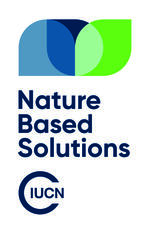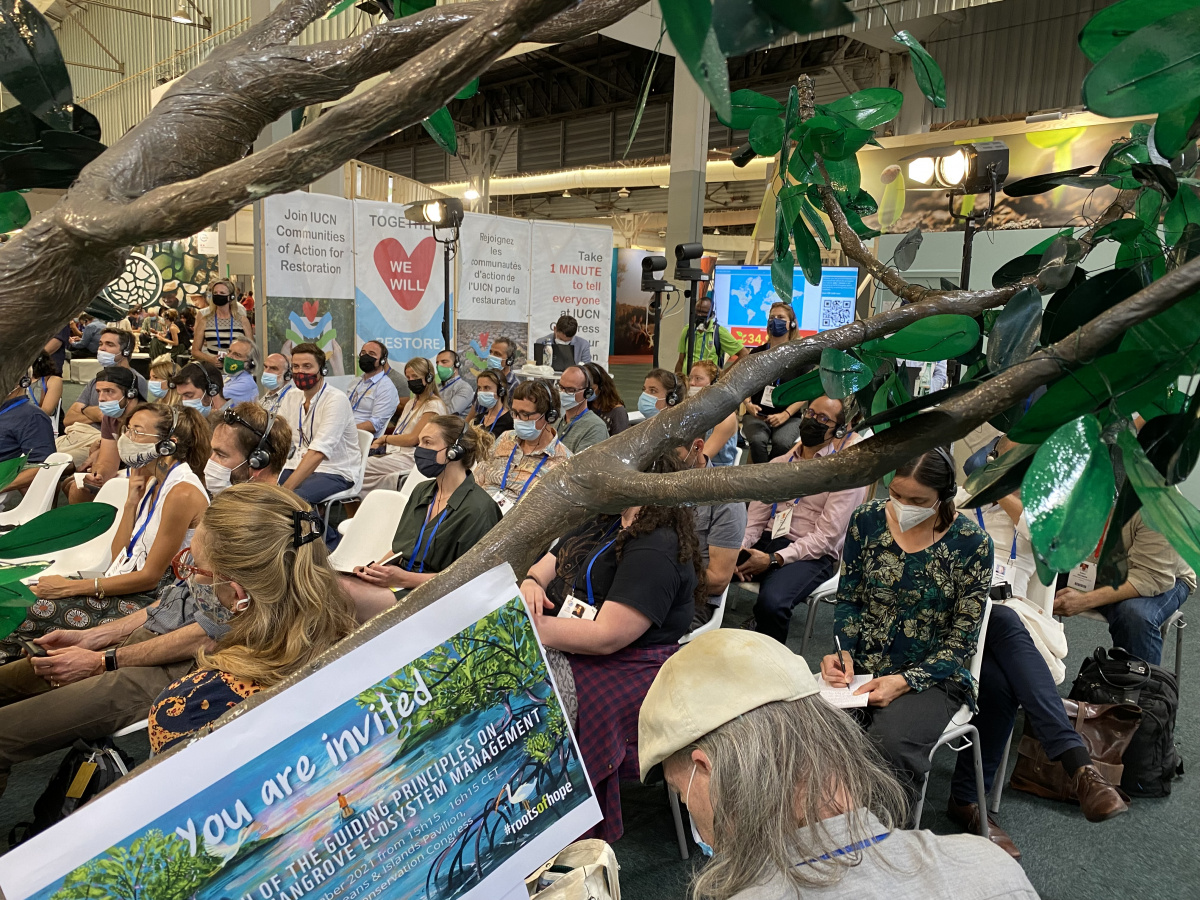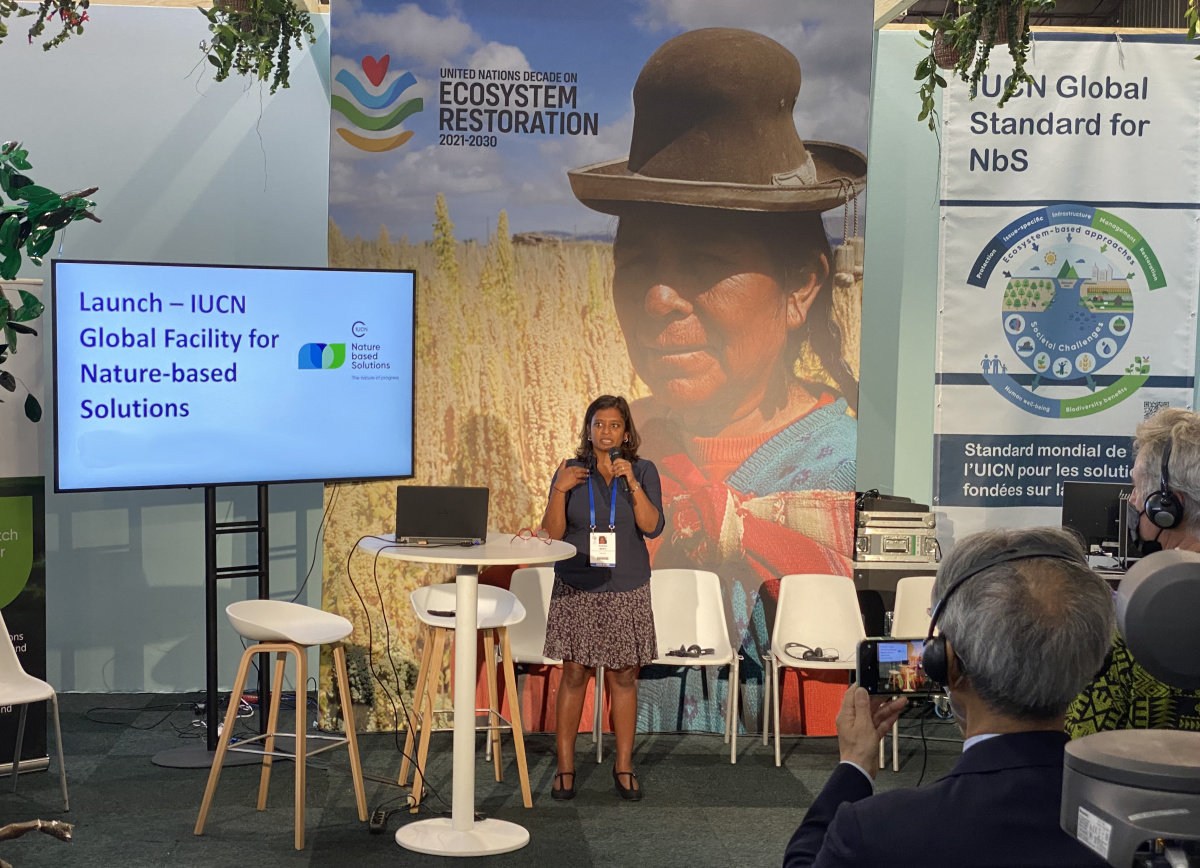A microcosm of natural solutions: The Nature-based Solutions and Ecosystem Restoration Pavilion at IUCN Congress
Deep in the exhibition hall of the IUCN World Conservation Congress in Marseille, the focus at the Nature-based Solutions (NbS) and Ecosystem Restoration pavilion was on the potential of NbS in solving societal challenges. This was highlighted by the launch of the Nature-Based Solutions Global Facility, cementing IUCN's vision for NbS by operationalising the wealth of knowledge, experience and resources of the Union and its partners. And that was just the beginning.
 Photo: IUCN
Photo: IUCN
1. NbS effectively address societal challenges
The overarching aim of NbS to address societal challenges was apparent across all sessions. For instance, in a session on Engagement for the Protection of the Congo Basin (video), experts made the case for a climate and biodiversity deal. Advocating for how protection and sustainable use of the Congo Basin ecosystems can improve biodiversity, provide climate adaptation benefits to local people and reduce carbon reliance.
2. Design of NbS is informed by scale
The pavilion hosted a focus group session that will contribute to creating an IUCN Roadmap of Agriculture and Land Health (video) aiming to use NbS in the integrated management of ecosystems to provide benefits from the farm-scale on up to larger landscapes – for well-being, sustainability and biodiversity.
3. NbS result in a net gain of biodiversity and ecosystem integrity
Biodiversity benefits are fundamental to defining NbS. For example, the Great Green Wall is an African-led collaboration to grow an 8,000 km wall of biodiversity-supporting vegetation across the the Sahel region for conservation and a range of other objectives, including social and livelihood projects. In semi-arid ecosystems like grasslands, degradation quickly leads to loss of endemic species in a system that may otherwise have a high biodiversity of plant and soil biota. NbS are being used to restore historical grasslands and increase plant and soil biodiversity.
4. NbS are economically viable
The economic viability of an NbS intervention must be evident to be sustainable. For example, an event showed how the Guatemalan Government, in partnership with IUCN and local NGOs, will successfully scale up ecosystem-based adaptation (video) based on existing restoration opportunities and investment from international donors, national programmes and existing local capacities.
5. NbS are based on inclusive, transparent and empowering governance processes
In partnership with the Global Territorial Alliance, indigenous peoples voiced how NbS need to be integrated with secure land rights and community-based approaches (video) to protect their lands’ ecological integrity and cultural heritage. This was underscored by an event on Amazonia 2.0 (video) where experiences were shared and lessons learned on the role of community monitoring and governance for NbS in key Amazonia basin landscapes. The event emphasised the importance of inclusive, transparent and empowering governance processes for effective NbS, promoted by local communities.
Engagement with youth was another focus of the pavilion’s governance sessions. Firstly, the Blue Peace (video) session looked at equity and participation, particularly of women and youth, in transboundary water management and provided specific actions on how to equip youth and women for water leadership. This event was complimentary to a session featuring the IUCN CEM Young professional network that looked to propose a way forward to increasing youth engagement in NbS (video) and another event focusing on Enhancement of Local Communities Including Women and Youth in the Implementation of FLR in West and Central Africa (video)
6. NbS equitably balance trade-offs between achievement of their primary goals and the continued provision of multiple benefits
While pledging to restore 130,000 hectares to the Bonn Challenge, a Minister from Belize described how the government adopted trade-offs in resource allocation between restoration projects and other services such as healthcare. This pledge [along with pledges from several others at a Bonn Challenge event (video)] demonstrated their commitment to NbS in the form of forest landscape restoration.
7. NbS are managed adaptively, based on evidence
Adaptive management was evident at a session for Grasslands Restoration: Actions on the Ground (video) that focused on restoring grasslands and protecting the culture and livelihoods of pastoral communities. The event challenged stereotypes of both pastoral communities and grasslands by statements reminding us that 'Land can't be marginal when you have a community depending on it'.
Adaptive management is crucial in grasslands as evidenced by the experiences of local people and their knowledge systems, implementing measures such as dry season enclosures and seed banks, managed by women.
8. NbS are sustainable and mainstreamed within an appropriate jurisdictional context
A session at the pavilion also explored Connectivity Networks as a Conservation and Restoration Tool in Honduras (video), a project with key stakeholders from government, co-management organisations and civil society through local indigenous groups. This technical session shared how the conservation and restoration of landscapes through biological corridors allows the establishment of biological connectivity networks, actively espousing NbS and their contribution to adaptation against climate change by creating spaces that allow greater resilience for species in their habitats.
Conclusion
While couching the NbS related events at the pavilion neatly into the eight criteria of the IUCN Global Standard for NbS required a bit of subjective reasoning, this exercise created a pathway to expose some of the diversity of the excellent sessions throughout the week.
Stay tuned for a complementary web story on the restoration-focused events from the pavilion at IUCN Congress.
Final note: A new way to prioritise NbS for biodiversity
Urgent action is required to reverse the decline of global biodiversity. A lack of data hampers efforts to measure progress and target actions. In this interesting event, we learned about how to get involved in an exciting new partnership between IUCN, NatureMetrics, NGOs, and businesses like Anglo American, using the power of eDNA to fill biodiversity knowledge gaps. It explored how the eBioAtlas Programme (video) can contribute to Sustainable Development Goals, help track restoration objectives, and prioritise conservation actions through NbS. They presented how eDNA surveys democratises the acquisition of biodiversity data, and discussed the importance of transparency and knowledge for the future, and how business and governments can contribute towards global biodiversity targets. By creating the world’s most comprehensive knowledge base on freshwater (& terrestrial) biodiversity, the eBioAtlas will contribute to identifying priority areas for biodiversity conservation and restoration, supporting the IUCN Red List and protected areas.
—Webstory by Eleanor Moore, Doctoral Student at Newcastle University, UK





